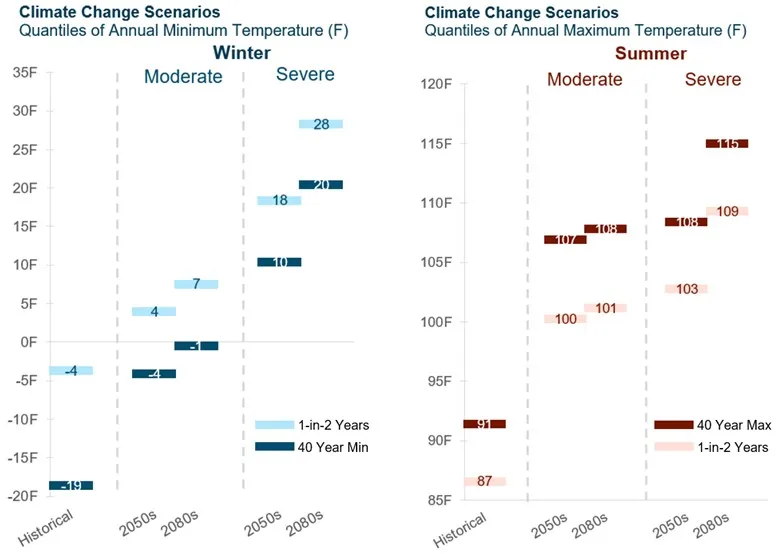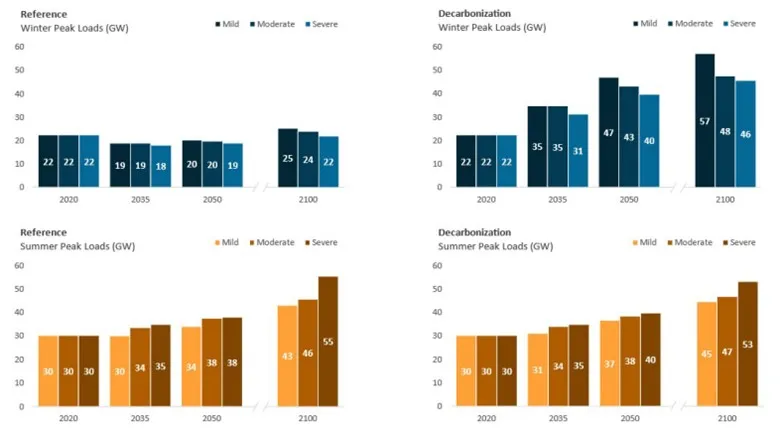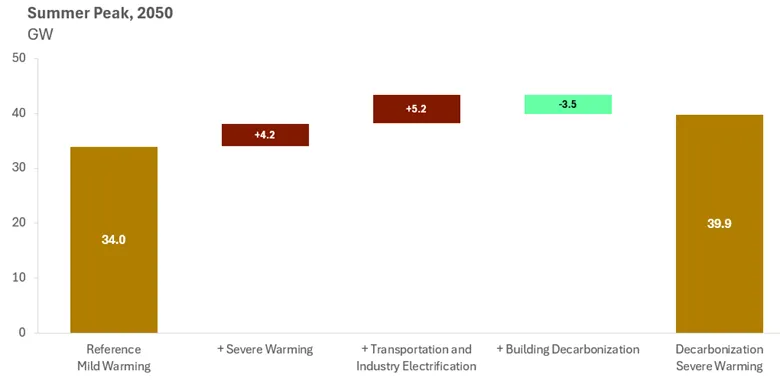Kevin Steinberger is a director, Vignesh Venugopal is a senior managing consultant, and Tory Clark is a partner at Energy and Environmental Economics (E3).
As another unusually hot summer has demonstrated, heat waves, floods and other extreme weather events are already testing grid resilience in every region of North America. To meet these challenges, electric systems must be well-planned and climate-aware. This is an increasingly urgent task that utilities, system operators (RTOs/ISOs) and other planning entities are beginning to execute. However, there is a key aspect of the transition to a more resilient grid that requires more attention: how the impacts of future climate change intersect with the transformations required to decarbonize the energy system.
Building an energy system that is both clean and resilient is possible with the right planning tools. Our analysis of the impacts of climate change in New York State finds that investments in building decarbonization, including measures such as energy efficiency and heat pumps, can have additional climate resilience benefits that are often overlooked.
As part of the New York State Climate Impacts Assessment: Understanding and Preparing for Our Changing Climate, the New York State Energy Research and Development Authority commissioned Energy and Environmental Economics to perform a detailed examination of the impacts of rising temperatures on the New York State energy system. In collaboration with Industrial Economics and Michael Craig of the University of Michigan, E3 incorporated hourly temperature projections into the same energy system modeling framework we used to support the New York State Climate Action Council Scoping Plan.
The analytical framework coupled (1) temperature projections under three climate change scenarios, and (2) the impacts of changes in temperature on key components of energy supply and demand to examine two infrastructure scenarios: a reference case reflecting less decarbonization investment and a Climate Act-compliant decarbonization scenario.
The analysis examined three warming scenarios, selected as illustrative bookends from a broader climate modeling exercise performed by Columbia University using general circulation models, including a “mild” scenario with no change in winter temperatures relative to today; a “severe” bookend scenario with very high levels of warming in both the summer and winter; and a “moderate” scenario with comparable levels of summer warming through 2050 but less pronounced impacts on winter temperatures (Figure 1).
Figure 1: Projected impacts of climate change on temperature in New York state

The impacts of warming on the ‘peak heat’ challenge
Under deep decarbonization scenarios, the electric system must grow significantly to meet newly electrified heating end-uses in cold climates. To meet its Climate Act goals, winter peaks in New York are expected to grow substantially under today’s climate conditions, approximately doubling to reach nearly 50 GW between 2022 and 2050.
Increased warming can partially reduce the electric infrastructure investments required by electrification-driven load growth. Our analysis finds that warming temperatures could lead to reductions in the decarbonization scenario winter peak of between 4 GW and 7 GW across moderate and severe levels of warming in 2050 (Figure 2).
Figure 2: Impacts of warming temperature on NYISO seasonal peak demand

However, meeting system peak needs in the winter remains a critically important challenge to solve under decarbonized futures, especially given the limited availability of certain resources. For example, times of high demand during the winter often coincide with reduced solar output as well as outage risks at thermal power plants due to freezing of plant equipment or fuel infrastructure.
It is also important to note there is still uncertainty associated with how climate change may impact extreme cold weather events, which may limit the extent to which electricity system planning is impacted by expectations of warmer winter extremes, especially given the importance of maintaining reliability during extreme cold as more customers rely on the electric system as their primary heating source.
Building decarbonization investments can offset the impacts of temperature rise on summer peaks
In a “reference” scenario, summer air conditioning needs drive peak electricity demand, and reliance on existing, relatively inefficient cooling equipment makes the New York grid very susceptible to warming temperatures. Our analysis finds that the summer peak in a reference scenario increases by between 3 GW and 12 GW (7%-28%) by late century under moderate and severe levels of warming relative to the mild warming scenario (Figure 2).
New York’s investments in decarbonization of the buildings sector, including investments in efficient building shells, would also have the added benefit of mitigating electricity system peak impacts in both seasons. Investments in building insulation and heat pumps — which are significantly more efficient than conventional air conditioning units — help to mitigate the impacts of rising temperatures on summer peak demand, adding value on top of the improved air quality and carbon benefits (Figure 3). Conversely, without investments in improved building shells and more efficient equipment like heat pumps, increasing summer temperatures lead to significantly higher cooling demand.
Figure 3: Combined impacts of warming temperatures and decarbonization investments on NYISO summer peak, 2050

In the decarbonization scenario the capacity added to meet electrification-driven winter peak demand is required to meet summer peaks as well; as a result, the resource portfolio is developed to meet system reliability needs across both the summer and winter seasons. By 2050, under severe levels of warming, the reference scenario requires nearly the same amount of capacity to maintain reliability in the summer despite having significantly lower levels of building and transportation electrification than the decarbonization scenario.
Rising summer temperatures will also impact electric infrastructure
The challenge associated with maintaining system reliability during summer peak demand periods is compounded by the impacts of rising temperatures on electric infrastructure. For example, higher temperatures lead to lower transfer capacity across the transmission system and reduced output from solar panels due to a fundamental reduction in efficiency. Warming also has a two-fold impact on thermal generators, increasing ambient temperature derates for combustion-based power plants and at the same time worsening their risk of unforced outages.
Many ISOs and utilities are already moving towards an effective load-carrying capability framework to capture the reliability contributions of intermittent and limited-duration resources such as wind, solar and battery storage. The same framework can and should be applied to thermal generators, which can experience correlated increases in outage risks during periods of high demand (during both extreme cold and extreme heat events). By accounting for the coincidence of thermal generator performance with reliability events, this framework would enhance system reliability under today’s climate conditions, provide a stronger incentive for weatherization of infrastructure, and be more adaptable to changing climate conditions in the future.
As the impacts of climate change intensify, it will become increasingly important for energy system planners to directly account for the effects that warming temperatures will have across every segment of the industry. Scenario design and sensitivity testing can be used to characterize critical sources of uncertainty, and ultimately planning frameworks will need to be highly adaptable in the face of ongoing uncertainty around how climate change and warming temperatures will impact energy supplies and demands.
By continuing to invest in climate modeling efforts and incorporating climate uncertainty into decarbonization planning, the industry will ensure that the significant investments made over the coming decades are robust to a broad range of plausible futures.





















